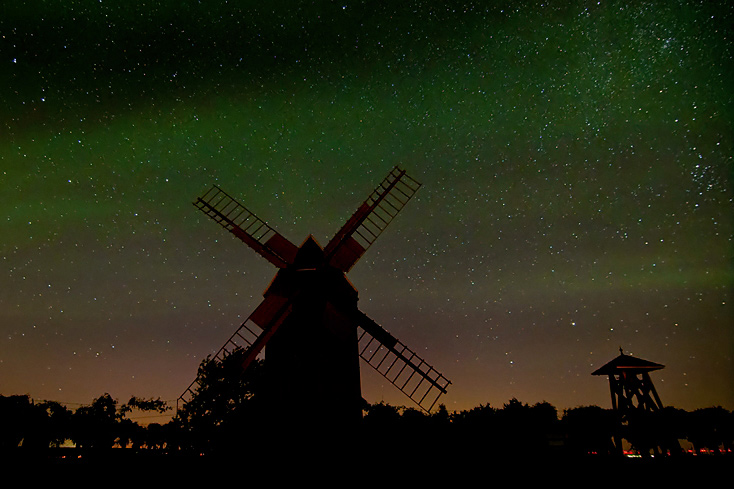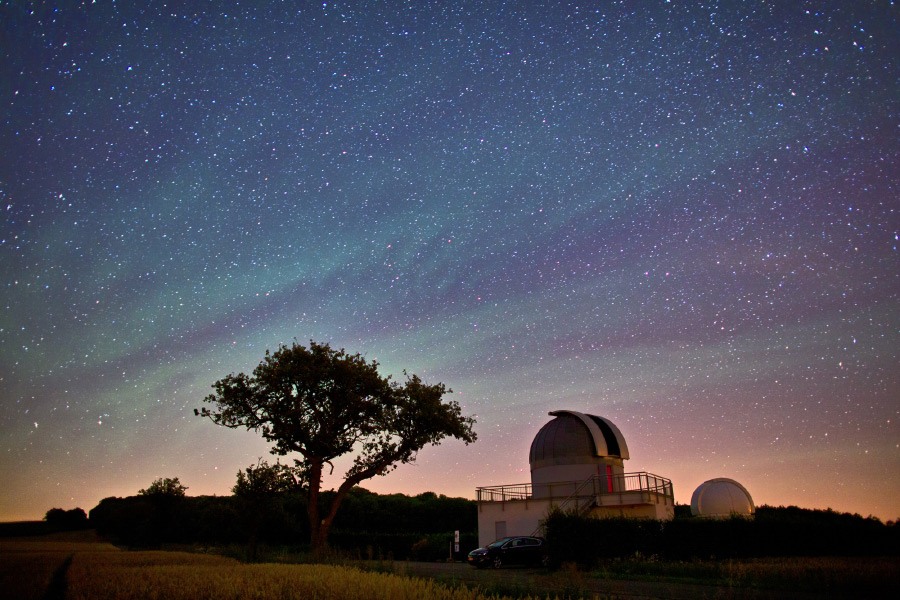Airglow occurs in the mesopause and thermosphere through light emissions from atoms and molecules excited by chemical processes. The sun's hard UV and X-ray radiation splits oxygen molecules (O2) into atomic oxygen (O). This process is responsible for the high temperatures in the thermosphere. Atomic oxygen recombines only very slowly into O2. It thus serves as a reservoir for the energy derived from UV radiation, driving chemical reactions at night that lead to the emission of airglow. The direct excitation of atoms and molecules by UV radiation cannot be responsible for the nocturnal airglow since they fall back to the ground state within periods of a few minutes at most, emitting light. Shortly after sunset, there would be no more airglow without the energy storage in the form of atomic oxygen. In fact, airglow on the day side of the Earth is about 1000 times stronger than on the night side. There, it is recognizable in photos taken from Earth's orbit as a predominantly green glowing layer. Its intensity fluctuates strongly and cannot be predicted on shorter time scales. At least for some of the emission lines involved, there is an apparent connection with the sunspot cycle. The more active the sun, the more UV light it emits, which in turn leads to increased formation of atomic oxygen in the upper atmosphere.
Airglow occurs, as mentioned above, through - partly complex - chemical reactions (
Examples) triggered by atomic oxygen. These occur at different altitudes depending on the atoms and molecules involved, each with specific emission lines. This results in various airglow layers at altitudes from about 85 to 300 kilometers:
86 - 87 km: Emissions in red and infrared light by hydroxyl (OH-) radicals
90 - 100 km: Emission in green light (558nm) by atomic oxygen
92 km: Emission in yellow light (approx. 590nm) by sodium (in the form of gaseous sodium bicarbonate)
95 km: Emission in blue light by molecular oxygen
150 - 300 km: Emissions in red light (630nm) by molecular oxygen
Upwards, the layers are limited by the fact that the density of the atoms and molecules involved becomes too low for the respective chemical reactions to occur on a notable scale. The lower boundaries mark the area where the excitation energy is dissipated through collision with other atoms and molecules before it can happen through the emission of light. Below about 86km, the atmospheric density is too high for airglow layers to exist. It is important to know that, for example, it takes 1 second for an excited O-atom to return to the ground state emitting light of wavelength 558nm. Under pressure conditions like those at the Earth's surface, an air molecule undergoes millions of collisions with other molecules during this period. Consequently, the typical emission lines of airglow cannot occur at normal pressure. They are therefore also referred to as "forbidden lines".
Airglow is noticeable not only in satellite photos but also from the ground, in the form of a faint general brightening of the sky, which unfortunately limits the performance of ground-based telescopes for astronomers. More intense airglow can be photographically detected in long-exposed sky images. Under favorable conditions, it can also be visually observed away from earthly light sources, usually appearing to the naked eye as a colorless to gray veil. This mainly involves the green layer at an altitude of 90 to 100 km. Photos not only show the color but typically also a structure of parallel bands that slowly move across the sky. The movement and structure result from gravity waves, which rise from the troposphere to the lower thermosphere, where they finally break due to the low air density. They thus do not reach the significantly higher red airglow layer, which is, therefore, largely structureless. In contrast, the deep red to infrared hydroxyl layer located at the mesopause also presents a banded structure in photos. In atmospheric research, hydroxyl airglow is used as a marker for dynamic processes in the upper atmosphere. Although airglow usually extends across the entire sky, it appears strongest 10 - 15 degrees above the horizon. Here, the perspective effect familiar from clouds comes into play. We are not looking vertically at a few kilometers thick layer of extremely low density, as near the zenith, but rather at almost the edge of a layer that extends horizontally over hundreds of kilometers. In immediate proximity to the horizon, the airglow falls victim to extinction. Although airglow and auroras share the green and red oxygen emission lines, they are based on different processes. Auroras result from the direct excitation of atoms and molecules by electrons from the solar wind, while airglow is indirectly caused by the sun's UV radiation.

